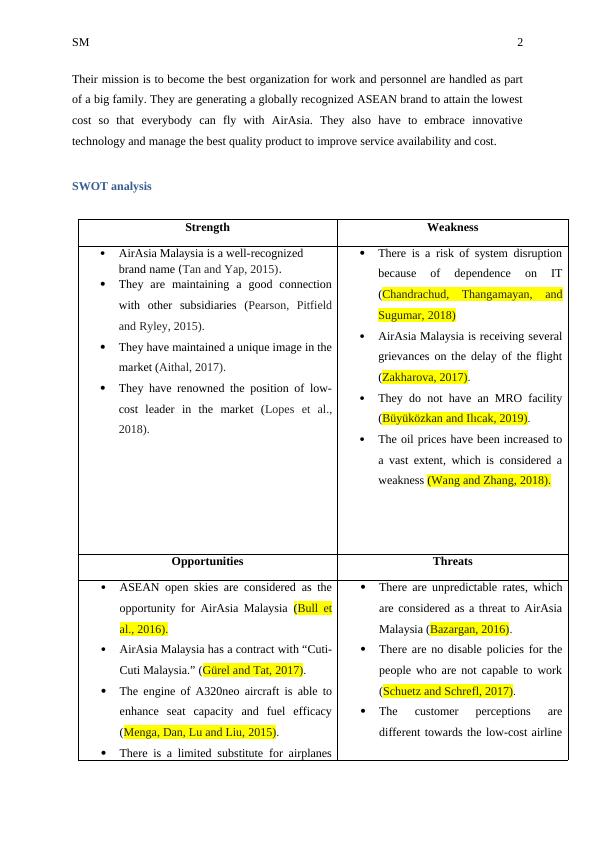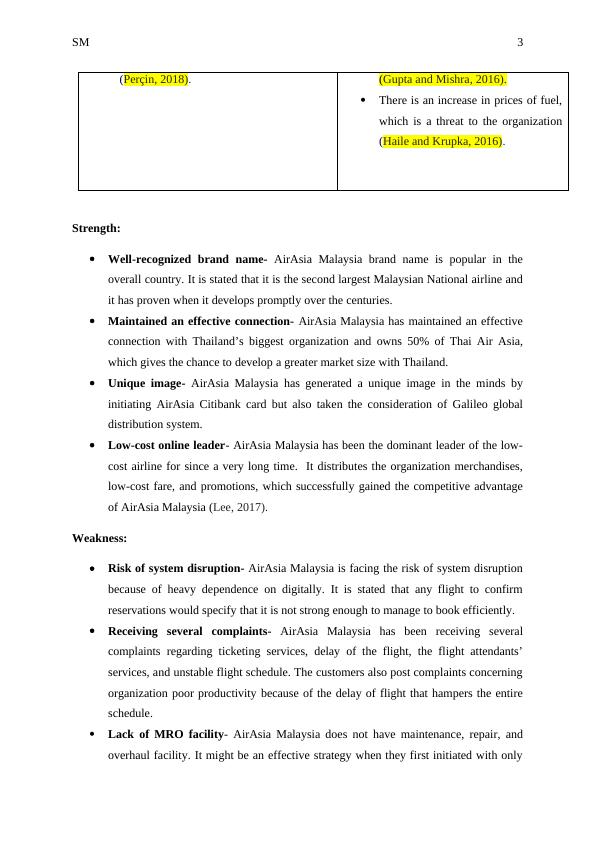Strategic Analysis of AirAsia Malaysia
Added on 2022-12-28
18 Pages5338 Words68 Views
Running Head: SM 0
AirAsia Malaysia
Strategic
Management
5/3/2019
AirAsia Malaysia
Strategic
Management
5/3/2019

SM 1
Introduction
The report carries out the discussion on strategic analysis to carry out individual research of
AirAsia Malaysia. IT further discusses the internal analysis involving the industry
environment and the organizational capabilities, which resulted in contribution towards the
poor performance of AirAsia Malaysia. It analyses to manage its value chain, resources
capabilities, and competencies, which can generate value and competitive advantage for the
organization. The discussion has also been made on the SWOT as well as Porter’s five forces
analysis, which is utilized to recognize the competitive positioning of AirAsia Malaysia in its
business environment (Asrah et al., 2018). In addition, analysis has been made on the
declared or undeclared strategies utilized by the company to develop its business. Finally, the
recommendation has been made on maintaining the competitive advantage of AirAsia
Malaysia.
Company background
AirAsia Malaysia was founded in 1993 and conduct operations on 18 November 1996. It is
Asia’s biggest low-cost airline and operates scheduled international as well as domestic
flights to 400 destinations in around 40 nations. Its main center is the low-cost Carrier
Terminal at Kuala Lumpur International Airport (Kong, 2018).
AirAsia Malaysia motivating carrier was built up with producing flying workable for
everybody. They have rapidly broken travel standards over the world that traverses through
more than 20 nations. They are focusing upon minimal effort through our proficient
processes, energetic way, and creative arrangement to deal with the business. Its associate
airlines are AirAsia Philippines, Thai AirAsia, AirAsia Japan, and Indonesia AirAsia in Clark
International Airport, Suvarnabhumi Airport, Narita International Airport, and Soekarno-
Hatta International Airport (Agus, 2018).
Vision:
Their vision is to be the biggest low-cost airline in Asia, which is providing 3 billion
individuals who are currently underserved with high fare and poor network.
Mission:
Introduction
The report carries out the discussion on strategic analysis to carry out individual research of
AirAsia Malaysia. IT further discusses the internal analysis involving the industry
environment and the organizational capabilities, which resulted in contribution towards the
poor performance of AirAsia Malaysia. It analyses to manage its value chain, resources
capabilities, and competencies, which can generate value and competitive advantage for the
organization. The discussion has also been made on the SWOT as well as Porter’s five forces
analysis, which is utilized to recognize the competitive positioning of AirAsia Malaysia in its
business environment (Asrah et al., 2018). In addition, analysis has been made on the
declared or undeclared strategies utilized by the company to develop its business. Finally, the
recommendation has been made on maintaining the competitive advantage of AirAsia
Malaysia.
Company background
AirAsia Malaysia was founded in 1993 and conduct operations on 18 November 1996. It is
Asia’s biggest low-cost airline and operates scheduled international as well as domestic
flights to 400 destinations in around 40 nations. Its main center is the low-cost Carrier
Terminal at Kuala Lumpur International Airport (Kong, 2018).
AirAsia Malaysia motivating carrier was built up with producing flying workable for
everybody. They have rapidly broken travel standards over the world that traverses through
more than 20 nations. They are focusing upon minimal effort through our proficient
processes, energetic way, and creative arrangement to deal with the business. Its associate
airlines are AirAsia Philippines, Thai AirAsia, AirAsia Japan, and Indonesia AirAsia in Clark
International Airport, Suvarnabhumi Airport, Narita International Airport, and Soekarno-
Hatta International Airport (Agus, 2018).
Vision:
Their vision is to be the biggest low-cost airline in Asia, which is providing 3 billion
individuals who are currently underserved with high fare and poor network.
Mission:

SM 2
Their mission is to become the best organization for work and personnel are handled as part
of a big family. They are generating a globally recognized ASEAN brand to attain the lowest
cost so that everybody can fly with AirAsia. They also have to embrace innovative
technology and manage the best quality product to improve service availability and cost.
SWOT analysis
Strength Weakness
AirAsia Malaysia is a well-recognized
brand name (Tan and Yap, 2015).
They are maintaining a good connection
with other subsidiaries (Pearson, Pitfield
and Ryley, 2015).
They have maintained a unique image in the
market (Aithal, 2017).
They have renowned the position of low-
cost leader in the market (Lopes et al.,
2018).
There is a risk of system disruption
because of dependence on IT
(Chandrachud, Thangamayan, and
Sugumar, 2018)
AirAsia Malaysia is receiving several
grievances on the delay of the flight
(Zakharova, 2017).
They do not have an MRO facility
(Büyüközkan and Ilıcak, 2019).
The oil prices have been increased to
a vast extent, which is considered a
weakness (Wang and Zhang, 2018).
Opportunities Threats
ASEAN open skies are considered as the
opportunity for AirAsia Malaysia (Bull et
al., 2016).
AirAsia Malaysia has a contract with “Cuti-
Cuti Malaysia.” (Gürel and Tat, 2017).
The engine of A320neo aircraft is able to
enhance seat capacity and fuel efficacy
(Menga, Dan, Lu and Liu, 2015).
There is a limited substitute for airplanes
There are unpredictable rates, which
are considered as a threat to AirAsia
Malaysia (Bazargan, 2016).
There are no disable policies for the
people who are not capable to work
(Schuetz and Schrefl, 2017).
The customer perceptions are
different towards the low-cost airline
Their mission is to become the best organization for work and personnel are handled as part
of a big family. They are generating a globally recognized ASEAN brand to attain the lowest
cost so that everybody can fly with AirAsia. They also have to embrace innovative
technology and manage the best quality product to improve service availability and cost.
SWOT analysis
Strength Weakness
AirAsia Malaysia is a well-recognized
brand name (Tan and Yap, 2015).
They are maintaining a good connection
with other subsidiaries (Pearson, Pitfield
and Ryley, 2015).
They have maintained a unique image in the
market (Aithal, 2017).
They have renowned the position of low-
cost leader in the market (Lopes et al.,
2018).
There is a risk of system disruption
because of dependence on IT
(Chandrachud, Thangamayan, and
Sugumar, 2018)
AirAsia Malaysia is receiving several
grievances on the delay of the flight
(Zakharova, 2017).
They do not have an MRO facility
(Büyüközkan and Ilıcak, 2019).
The oil prices have been increased to
a vast extent, which is considered a
weakness (Wang and Zhang, 2018).
Opportunities Threats
ASEAN open skies are considered as the
opportunity for AirAsia Malaysia (Bull et
al., 2016).
AirAsia Malaysia has a contract with “Cuti-
Cuti Malaysia.” (Gürel and Tat, 2017).
The engine of A320neo aircraft is able to
enhance seat capacity and fuel efficacy
(Menga, Dan, Lu and Liu, 2015).
There is a limited substitute for airplanes
There are unpredictable rates, which
are considered as a threat to AirAsia
Malaysia (Bazargan, 2016).
There are no disable policies for the
people who are not capable to work
(Schuetz and Schrefl, 2017).
The customer perceptions are
different towards the low-cost airline

SM 3
(Perçin, 2018). (Gupta and Mishra, 2016).
There is an increase in prices of fuel,
which is a threat to the organization
(Haile and Krupka, 2016).
Strength:
Well-recognized brand name- AirAsia Malaysia brand name is popular in the
overall country. It is stated that it is the second largest Malaysian National airline and
it has proven when it develops promptly over the centuries.
Maintained an effective connection- AirAsia Malaysia has maintained an effective
connection with Thailand’s biggest organization and owns 50% of Thai Air Asia,
which gives the chance to develop a greater market size with Thailand.
Unique image- AirAsia Malaysia has generated a unique image in the minds by
initiating AirAsia Citibank card but also taken the consideration of Galileo global
distribution system.
Low-cost online leader- AirAsia Malaysia has been the dominant leader of the low-
cost airline for since a very long time. It distributes the organization merchandises,
low-cost fare, and promotions, which successfully gained the competitive advantage
of AirAsia Malaysia (Lee, 2017).
Weakness:
Risk of system disruption- AirAsia Malaysia is facing the risk of system disruption
because of heavy dependence on digitally. It is stated that any flight to confirm
reservations would specify that it is not strong enough to manage to book efficiently.
Receiving several complaints- AirAsia Malaysia has been receiving several
complaints regarding ticketing services, delay of the flight, the flight attendants’
services, and unstable flight schedule. The customers also post complaints concerning
organization poor productivity because of the delay of flight that hampers the entire
schedule.
Lack of MRO facility- AirAsia Malaysia does not have maintenance, repair, and
overhaul facility. It might be an effective strategy when they first initiated with only
(Perçin, 2018). (Gupta and Mishra, 2016).
There is an increase in prices of fuel,
which is a threat to the organization
(Haile and Krupka, 2016).
Strength:
Well-recognized brand name- AirAsia Malaysia brand name is popular in the
overall country. It is stated that it is the second largest Malaysian National airline and
it has proven when it develops promptly over the centuries.
Maintained an effective connection- AirAsia Malaysia has maintained an effective
connection with Thailand’s biggest organization and owns 50% of Thai Air Asia,
which gives the chance to develop a greater market size with Thailand.
Unique image- AirAsia Malaysia has generated a unique image in the minds by
initiating AirAsia Citibank card but also taken the consideration of Galileo global
distribution system.
Low-cost online leader- AirAsia Malaysia has been the dominant leader of the low-
cost airline for since a very long time. It distributes the organization merchandises,
low-cost fare, and promotions, which successfully gained the competitive advantage
of AirAsia Malaysia (Lee, 2017).
Weakness:
Risk of system disruption- AirAsia Malaysia is facing the risk of system disruption
because of heavy dependence on digitally. It is stated that any flight to confirm
reservations would specify that it is not strong enough to manage to book efficiently.
Receiving several complaints- AirAsia Malaysia has been receiving several
complaints regarding ticketing services, delay of the flight, the flight attendants’
services, and unstable flight schedule. The customers also post complaints concerning
organization poor productivity because of the delay of flight that hampers the entire
schedule.
Lack of MRO facility- AirAsia Malaysia does not have maintenance, repair, and
overhaul facility. It might be an effective strategy when they first initiated with only

End of preview
Want to access all the pages? Upload your documents or become a member.
Related Documents
Air Asia Blue Ocean Strategy: Assignmentlg...
|12
|2924
|225
Management of AirAsia: Cost Structure, Revenue Stream, and Channelslg...
|8
|1605
|475
Management of Air Asia Berhadlg...
|10
|2081
|200
Business Analysis of AirAsia Berhad | Reportlg...
|18
|4931
|28
Air Asia: External Influenceslg...
|7
|1418
|433
Leadership and Motivation Theories Assignment 2022lg...
|13
|3021
|12
